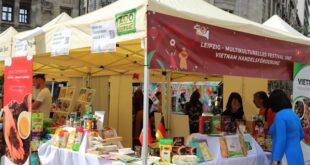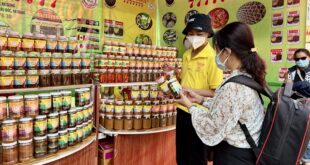
|
| The 7th Áo Dài Festival opens in HCM City in 2020. VNA Photo |
HCM City – Leveraging its unique advantages and competitive capacity, HCM City has chosen eight key cultural industries for development between now and 2030 to become a cultural industry centre in Southeast Asia.
Key areas of focus are film, performing arts, fine arts, photography, exhibitions, advertising, cultural tourism, and fashion.
The city’s objective is to ensure that its cultural products and services gain a reputable brand both regionally and internationally, meet the standards of developed countries, and join regional and global cultural value chains.
Optimising potential
Nguyễn Thị Thanh Thúy, Deputy Director of the municipal Department of Culture and Sports, highlighted the significant role of cultural industries in preserving cultural values, promoting cultural heritage, national image and turning cultural potential into services, spearhead economic areas.
The city has 17,670 businesses operating in cultural production and services, accounting for approximately 7.74 per cent of all local enterprises. The contribution of cultural industries to the city’s Gross Regional Domestic Product (GRDP) has been increasing annually, affirming the sector’s importance to the local economy.
The production value of cultural industries was over 36.094 trillion VNĐ (US$1.5 billion) in 2010, and risen to more than VNĐ75 trillion in 2019, contributing 3.98 per cent to the city’s GRDP, with advertising as the largest contributor.
In 2020, the COVID-19 pandemic severely impacted the sector, with a contribution of 3.54 per cent of the city’s total GRDP.
Recognising the sector’s growth potential, the HCM City People’s Committee on October 25, 2023 issued Decision No 4853/QD-UBND approving the project on HCM City’s cultural industry development until 2030.
The project is divided into two phases: Phase 1 from now until the end of 2025, and Phase 2 from 2026 to 2030.
In Phase 1, the city will focus on developing itself to the country’s cultrual industry hub by investing in appropriate resources, encouraging the involvement of all society, and focusing on the development of advantageous and high-value sectors.
In Phase 2, the city will aim to diversify and modernise all local cultural industries in a sustainable manner, and apply advanced technology to become a cultural industry centre in Southeast Asia, while striving to join the UNESCO’s creative cities network in the field of cinematography.
Gradually developing cultural industries
The city eyes an average annual growth rate of approximately 14 per cent in cultural industries by 2025, contributing about 5.7 per cent to the city’s GRDP and generating more jobs. By 2030, the city targets the sector’s average growth rate of 12 per cent per year, contributing approximately 7-8 per cent to the GRDP.
The anticipated total revenue from the eight selected cultural industries is projected to contribute about VNĐ148 trillion to the city’s socioeconomic growth.
To ensure the success of the 2030 cultural industry development project, the city has outlined specific tasks for each of the eight cultural industries.
Cinematography is identified as a key strength. The city plans to support film projects with local cultural features, establish creative spaces, and create public events such as the HCM City Short Film Festival and the HCM City International Film Festival.
Additionally, the city plans to develop production cooperation programmes, and film distribution channels, call for investment from both domestic and international partners, and study the formation of a film development fund.
For cultural tourism, specific tasks include the development of cultural tourism programmes and destinations in the city, digitising heritage data, applying technology 4.0 in cultural heritage management and tourism development, organising annual conferences connecting regional cultural tourism, reviving traditional festivals, and building new modern festival events.
To effectively implement the cultural industry development project, HCM City will enhance the training and development of human resources, invest in infrastructure, and build distinctive cultural products and services of the eight selected industries. – VNA/VNS
- Reduce Hair Loss with PURA D’OR Gold Label Shampoo
- Castor Oil Has Made a “Huge” Difference With Hair and Brow Growth
- Excessive hair loss in men: Signs of illness that cannot be subjective
- Dịch Vụ SEO Website ở Los Angeles, CA: đưa trang web doanh nghiệp bạn lên top Google
- Nails Salon Sierra Madre
 VnExpress News The News Gateway of Vietnam
VnExpress News The News Gateway of Vietnam





